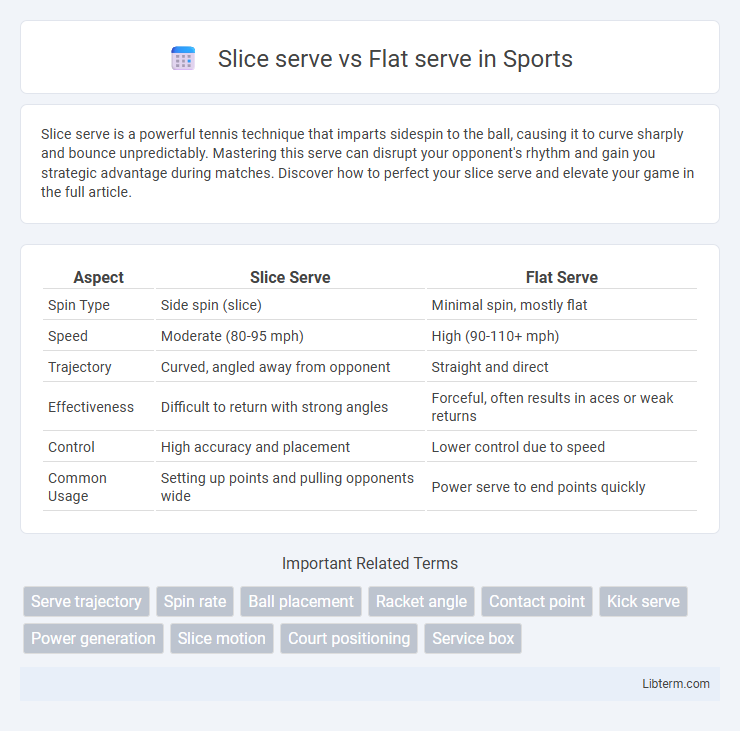Slice serve is a powerful tennis technique that imparts sidespin to the ball, causing it to curve sharply and bounce unpredictably. Mastering this serve can disrupt your opponent's rhythm and gain you strategic advantage during matches. Discover how to perfect your slice serve and elevate your game in the full article.
Table of Comparison
| Aspect | Slice Serve | Flat Serve |
|---|---|---|
| Spin Type | Side spin (slice) | Minimal spin, mostly flat |
| Speed | Moderate (80-95 mph) | High (90-110+ mph) |
| Trajectory | Curved, angled away from opponent | Straight and direct |
| Effectiveness | Difficult to return with strong angles | Forceful, often results in aces or weak returns |
| Control | High accuracy and placement | Lower control due to speed |
| Common Usage | Setting up points and pulling opponents wide | Power serve to end points quickly |
Introduction to Tennis Serves
Slice serve in tennis applies side spin to the ball, causing it to curve away from the opponent, enhancing placement and making returns more challenging. Flat serve delivers the ball with minimal spin and maximum speed, aiming for powerful, straight shots that reduce the opponent's reaction time. Both serves are fundamental in tennis strategy, with slice serves offering control and deception, while flat serves prioritize velocity and directness.
What is a Slice Serve?
A slice serve is a tennis serve technique that imparts side-spin on the ball, causing it to curve and bounce unpredictably to the opponent's side. This spin is generated by brushing the racket face across the ball at a slight angle, making it an effective tool for wide serves that pull opponents off the court. Compared to a flat serve, the slice serve offers more control and variation, disrupting the opponent's rhythm with its lateral movement.
What is a Flat Serve?
A flat serve in tennis is characterized by minimal spin and maximum ball speed, delivering a straight trajectory that makes it difficult for opponents to anticipate. This serve technique involves striking the ball with a firm, flat racket face to generate power while keeping the ball's flight path low and fast. Ideal for aggressive players, the flat serve often results in aces or weak returns due to its speed and direct placement.
Key Differences Between Slice and Flat Serves
Slice serves create lateral spin by brushing the ball's side, causing it to curve in flight and bounce unpredictably, ideal for disrupting the opponent's rhythm. Flat serves generate minimal spin, resulting in a faster, more direct trajectory that emphasizes power and speed. The key difference lies in spin type and ball trajectory, with slice serves prioritizing control and deception, while flat serves maximize pace and aggression.
When to Use a Slice Serve
A slice serve is ideal for players looking to create sharp angles and disrupt their opponent's rhythm, especially on the deuce side where the spin naturally curves away from right-handed receivers. Flat serves offer maximum speed and power but lack the lateral movement that a slice serve provides, making the slice serve a strategic choice on slower surfaces or against baseline players. When precision and placement are more critical than pure speed, the slice serve can effectively force weak returns or open up the court for the next shot.
When to Use a Flat Serve
A flat serve is ideal when aiming for maximum speed and power, making it effective during first serves to pressure the opponent early in the point. It reduces spin for a faster, more direct trajectory, which is advantageous on fast court surfaces like grass or hard courts. Players use flat serves to gain quick points, especially when targeting the service box corners with precision.
Advantages of the Slice Serve
The slice serve offers greater ball control and spin, causing the ball to curve unpredictably and making it challenging for opponents to return. This type of serve generates a sideways spin that enhances placement precision and can exploit an opponent's weaker backhand or forehand. By combining speed with spin, the slice serve increases the likelihood of forcing weak returns or aces, giving servers a tactical advantage in matches.
Advantages of the Flat Serve
The flat serve offers superior speed and power, making it ideal for aggressive players seeking to dominate points quickly. Its minimal spin results in a more direct trajectory, increasing the likelihood of aces and service winners. Compared to the slice serve, the flat serve minimizes side spin, reducing the opponent's reaction time and improving overall serve efficiency.
Common Mistakes with Slice and Flat Serves
Common mistakes with slice serves include improper wrist snap and insufficient racket face angle, leading to lack of spin and control. Flat serves often suffer from hitting the ball too early or late, causing inconsistent power and placement. Both serve types require precise timing and technique to maximize effectiveness and minimize errors.
Choosing the Right Serve for Your Game
Choosing the right serve between a slice serve and a flat serve depends on your playing style and court strategy. Slice serves generate side spin, causing the ball to curve and bounce away from your opponent, making it ideal for players who want to create angles and disrupt rhythm. Flat serves deliver maximum speed and power with minimal spin, making them effective for aggressive players aiming to score quick points with sheer pace.
Slice serve Infographic

 libterm.com
libterm.com